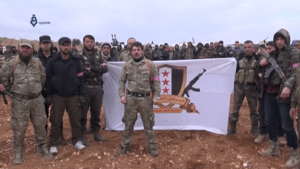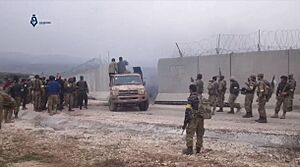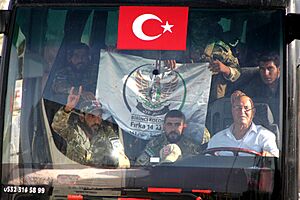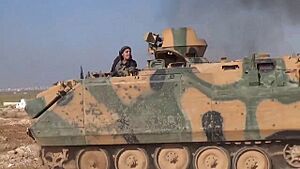Syrian National Army facts for kids
Quick facts for kids Syrian National Army |
|
|---|---|
| الجيش الوطني السوري Participant in the Syrian Civil War |
|
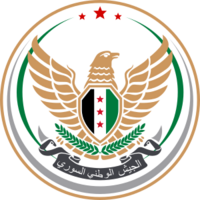 Emblem 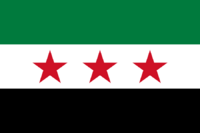 Flag |
|
| Active | 2017–present |
| Ideology | Syrian opposition Anti-Assadism Main Ideas: Sunni Islamism Kurdish nationalism Turkish nationalism Democracy Secularism |
| Allegiance | |
| Leaders | Salem al-Meslet (President of SIG) Abdurrahman Mustafa (Prime Minister of SIG) Brig. Gen. Hasan Hamadah (Minister of Defense and Chief of Staff) Brig. Gen. Adnan al-Ahmad (Deputy Chief of Staff) Brig. Gen. Fadlallah al-Haji (Deputy Chief of Staff) |
| Headquarters | Azaz, Aleppo Governorate |
| Area of operations | Northern Syria
Western Libya
|
| Allies | |
| Opponents | |
| Battles and wars | Syrian Civil War
|
The Syrian National Army (SNA), also known as the Turkish-backed Free Syrian Army, is a group of armed Syrian opposition fighters. They are involved in the Syrian Civil War. This group was officially formed in 2017 with help from Turkey. Turkey provides them with money, training, and military support.
The SNA grew from the Free Syrian Army (FSA). The FSA was a group of opposition fighters started in July 2011 by Syrian military officers who left the army. Turkey began helping the FSA in November 2011 by giving them weapons, training, and a safe place. Over time, the FSA became weaker due to internal fights and a lack of money.
In 2016, Turkey helped create a new group of Syrian fighters, which included many former FSA members. This was done to make a stronger opposition force. After a military operation called Operation Euphrates Shield, the Turkish government worked with the Syrian Interim Government to create the "National Army." Their goal was to protect the areas Turkey had gained control of.
The main goals of the SNA are to create a safe area in northern Syria, join with other rebel groups, and fight against Syrian government forces and other armed groups. The SNA also expanded into the Idlib Governorate in 2019. They then joined with another group called the National Front for Liberation in October 2019.
The SNA works closely with the Turkish government. Some people describe them as an "auxiliary army" of the Turkish Armed Forces or as "mercenaries." Outside Syria, Turkey has sent SNA fighters to help in conflicts in places like Libya and the south Caucasus. Most SNA fighters are Arabs and Syrian Turkmen.
Contents
Who Makes Up the Syrian National Army?
The Syrian National Army has at least 25,000 fighters, and some reports suggest it could be as many as 70,000. Most of these fighters are Arabs and Syrian Turkmen. There are also some Syrian Kurds in the SNA, though their numbers are smaller. In 2018, a SNA commander said that about 350 Kurds were part of the group.
By the middle of 2017, many Turkish-backed FSA groups reorganized into three main military sections: Victory, Sultan Murad, and the Levant. Other groups remained separate. On December 30, 2017, these groups officially joined to form the National Army. They created three main "legions": the 1st, 2nd, and 3rd. Later, a 4th Legion was formed in northern Homs Governorate and then moved to northern Aleppo.
On October 4, 2019, the National Front for Liberation joined the National Army. They planned to become the 4th, 5th, 6th, and 7th legions. This merger happened during a press conference in Turkey, as Turkey planned a new operation against the Syrian Democratic Forces (SDF).
Some reports from 2019 suggest that many of the groups within the Syrian National Army had previously received support from the United States. This support included training programs and anti-tank missiles. In April 2021, a new military group called 'al-Quwat al-Radifa' (Auxiliary Forces) was formed in Idlib.
How the SNA Works with Turkey

The Free Syrian Army (FSA) has been closely linked with Turkey since the start of the Turkish involvement in the Syrian Civil War. Turkey was a safe place for the FSA and a source of supplies. After 2015, Turkey's influence grew as other countries reduced their involvement in the conflict. This made rebel groups more reliant on Turkey's help.
The Turkish government pays the wages of the Turkey-backed FSA fighters. These fighters also work alongside the Turkish Armed Forces. Injured Turkey-backed FSA troops are often treated in Turkey.
The Free Police, a group linked to the SNA, has clear connections to Turkey. They reportedly wear Turkish police uniforms. Some even wore a Turkish flag patch on their uniforms during a ceremony in 2017.
Key Military Actions
The Syrian National Army has taken part in several important military operations.
Operation Euphrates Shield (2016)
The SNA's first major action was a joint operation with the Turkish Armed Forces called Operation Euphrates Shield. On the first day, they took control of Jarabulus from ISIS. They then moved northeast, clashing with the Syrian Democratic Forces (SDF). The SNA pushed the SDF out of the Jarablus area. The Euphrates river became a dividing line between the two sides.
Later, the SNA and Turkish forces pushed ISIS further south. They also had some clashes with SDF forces from the Afrin Canton. In February 2017, the SNA and Turkish forces surrounded and captured al-Bab. By February 2017, 470 SNA fighters had died in Operation Euphrates Shield, while 68 Turkish soldiers were lost.
By March 2017, the SNA and Turkish army were stopped from moving further east. This happened when the SDF handed over some land to the Syrian Army, creating a buffer zone. As a result, the SNA could not capture the SDF-held city of Manbij or join the fight for Raqqa. In September 2017, the Hamza Division, part of the SNA, opened a military academy in al-Bab to train fighters for a "Syrian National Army."
Operation Olive Branch (2018)
On January 20, 2018, Turkey launched a new operation in the Afrin Region against the Kurdish-led Democratic Union Party (PYD). The SNA carried out ground attacks against the YPG and SDF. They were supported by Turkish air strikes, artillery, armored units, and special forces.
The first goal of the operation was to take control of the entire Afrin-Turkey border. On February 1, the SNA captured the town of Bulbul after a tough fight. By early March, the second phase of Operation Olive Branch began. On March 3, the SNA captured Rajo, and on March 8, they took Jinderes. This meant they controlled all major roads leading to Afrin city. On March 13, SNA forces reached and surrounded Afrin city. On March 18, the SNA took full control of Afrin. Since then, SNA forces have been working to clear mines and bring safety to the area.
Operations in 2019
By August 16, 2019, the SNA sent many more fighters to the front lines in Hama and Idlib. This was to help against an offensive by the Syrian Arab Army. After this, rebel forces launched a strong attack on the village of Sukayk.
On October 9, 2019, the Turkish Armed Forces and the Syrian National Army launched Operation Peace Spring. Their goal was to remove what Turkish President Erdogan called "the threat of terror" against Turkey. On October 13, these forces captured the border town of Tal Abyad. After the Second Battle of Ras al-Ayn ended on October 20, SDF fighters left Ras al Ain during a ceasefire. By November 25, the operation was finished, and the areas between Ras al Ain and Tal Abyad were secured.
Ayn Issa Clashes (2020)
On December 2, 2020, it was reported that the SDF managed to surprise Turkish-backed forces, killing 30 fighters.
Operations Outside Syria
The Syrian National Army has also been involved in conflicts outside Syria.
Libya Operations
Since 2020, Turkey has been sending fighters from the Syrian National Army to Libya. They help the GNA in the Second Libyan Civil War. Some SNA groups volunteered for this, even though the Syrian Interim Government had objections. Sadly, many fighters have died in combat there.
Azerbaijan Operations
In September 2020, Turkey sent 2,580 fighters from the Syrian National Army to fight in Nagorno-Karabakh. Reports indicate that many of these fighters died in combat.
Niger Operations
In January 2024, it was reported that Turkey had sent SNA fighters to Niger. They are helping in the fight against ISIS there. By May 2024, more SNA members were sent to Niger by Turkey's intelligence agency.
Iraq Operations
In July 2024, it was reported that Turkey had sent SNA fighters to northern Iraq. They are involved in the conflict between Turkey and the Kurdistan Workers' Party (PKK). Around 400 fighters from different SNA divisions were expected to join this mission. Some SNA fighters have been captured by the PKK.
Internal Conflicts
Sometimes, different groups within the Syrian National Army have had disagreements or clashes.
In March 2016, a group called Ahrar ash-Sham reportedly told a Kurdish FSA group to remove the flag of Kurdistan. However, the Kurdish group's commander denied this happened. In September 2016, some Ahrar al-Sham fighters publicly burned an FSA flag, which caused protests.
In November 2016, two groups, the Levant Front and the Sultan Murad Division, clashed at the border. Other groups joined the fight, saying the Levant Front leaders were "acting like gangs."
In April 2017, Ahrar al-Sham reportedly attacked another group and captured some of their fighters. They were later released after talks. In April 2017, more clashes happened between the Levant Front and the Sultan Suleyman Shah Brigade. Other groups sided with the Sultan Suleyman Shah Brigade.
In May 2017, there were fights between the Ahrar al-Sharqiya Brigade and the Sultan Murad Division and the Sham Legion. The fighting stopped when the Turkish Army stepped in. Later that month, the Levant Front attacked the Sham Legion, saying they were working with another group.
Between May 24 and 25, 2017, five SNA groups attacked the Revolutionary Knights Brigade. They captured many fighters and accused the brigade of smuggling, looting, and harming civilians.
From June 4 to 15, 2017, heavy fighting broke out between SNA groups led by the Sultan Murad Division and Ahrar al-Sham near al-Bab. Many people were killed and injured. Some fighters even left the SNA to join the Syrian Army or the Syrian Democratic Forces during these clashes.
In July 2017, the commander of the Descendants of Saladin Brigade said his group would not join a Turkish-led attack. After this, other Turkish-backed groups attacked his unit and took their weapons. The commander was later captured and questioned by Turkish forces. He said that Turkey seemed only interested in using Syrian groups for its own goals.
In March 2018, after the capture of Afrin, clashes happened between the Hamza Division and Ahrar al-Sharqiya in the city. A ceasefire was signed with Turkey's help. In November 2018, more clashes in Afrin killed many fighters from different groups.
Images for kids


